AAF043-6: Management Accounting, Financial Planning & Investment
VerifiedAdded on 2023/06/17
|12
|3802
|314
Report
AI Summary
This report delves into management accounting and financial planning, emphasizing the role of managerial accountants in guiding financial performance. It explores the use of consumption expenditure in pricing strategies, examines the benefits and limitations of fiscal administration systems in investment decisions (including payback period, NPV, ARR and IRR), and analyzes the importance of preparation as a strategic management accounting tool for businesses recovering from the Covid-19 pandemic. The report also discusses approaches tax authorities use to determine the reasonableness of transactional inventory prices. It highlights that appropriate costing focuses on relevant expenses for decision-making, especially in short-term scenarios, and underscores the significance of both short-term and long-term financial evaluations. The document is contributed by a student and available on Desklib.

1. Management
accounting and
financial planning
AAF043-6
accounting and
financial planning
AAF043-6
Paraphrase This Document
Need a fresh take? Get an instant paraphrase of this document with our AI Paraphraser
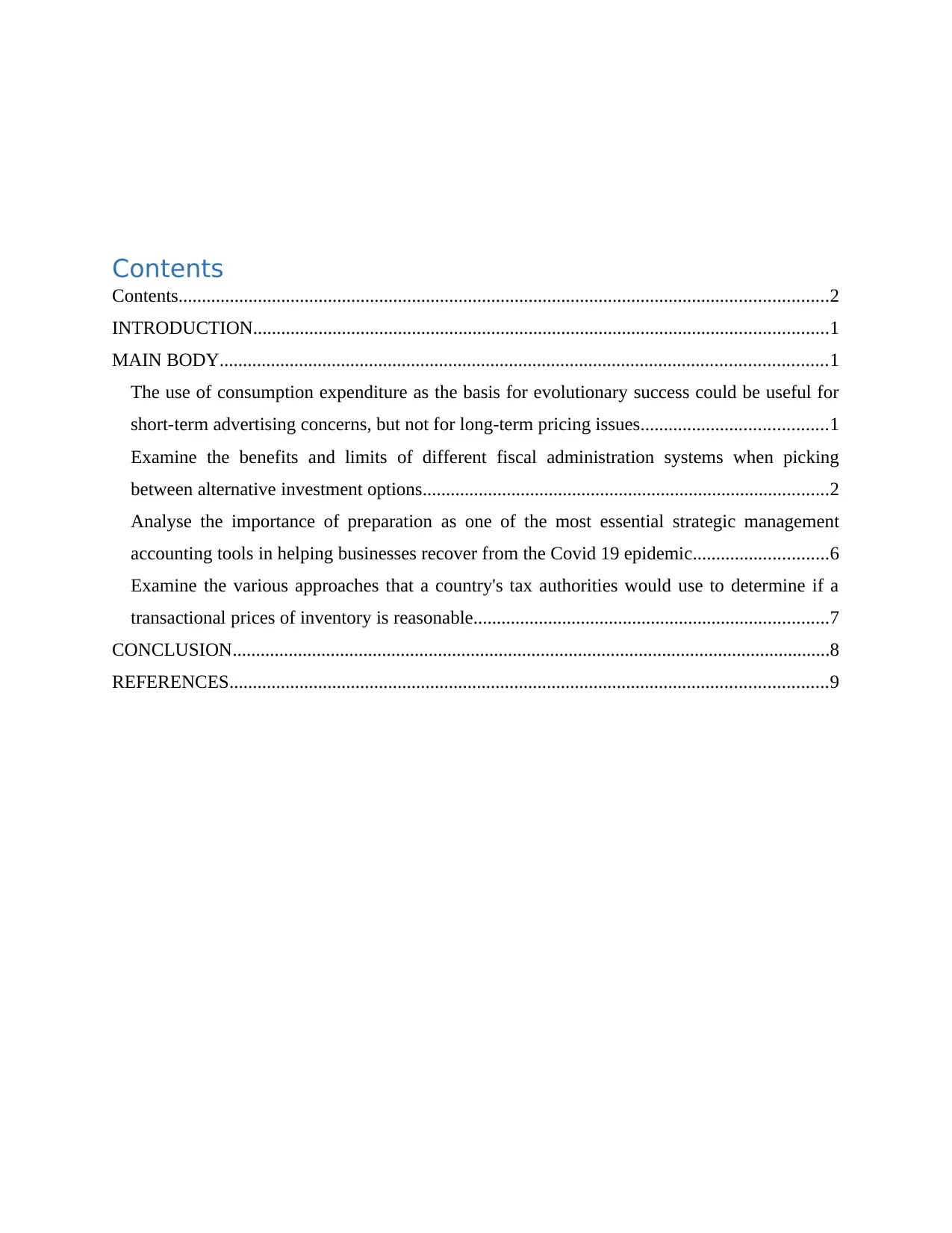
Contents
Contents...........................................................................................................................................2
INTRODUCTION...........................................................................................................................1
MAIN BODY..................................................................................................................................1
The use of consumption expenditure as the basis for evolutionary success could be useful for
short-term advertising concerns, but not for long-term pricing issues........................................1
Examine the benefits and limits of different fiscal administration systems when picking
between alternative investment options.......................................................................................2
Analyse the importance of preparation as one of the most essential strategic management
accounting tools in helping businesses recover from the Covid 19 epidemic.............................6
Examine the various approaches that a country's tax authorities would use to determine if a
transactional prices of inventory is reasonable............................................................................7
CONCLUSION................................................................................................................................8
REFERENCES................................................................................................................................9
Contents...........................................................................................................................................2
INTRODUCTION...........................................................................................................................1
MAIN BODY..................................................................................................................................1
The use of consumption expenditure as the basis for evolutionary success could be useful for
short-term advertising concerns, but not for long-term pricing issues........................................1
Examine the benefits and limits of different fiscal administration systems when picking
between alternative investment options.......................................................................................2
Analyse the importance of preparation as one of the most essential strategic management
accounting tools in helping businesses recover from the Covid 19 epidemic.............................6
Examine the various approaches that a country's tax authorities would use to determine if a
transactional prices of inventory is reasonable............................................................................7
CONCLUSION................................................................................................................................8
REFERENCES................................................................................................................................9

⊘ This is a preview!⊘
Do you want full access?
Subscribe today to unlock all pages.

Trusted by 1+ million students worldwide
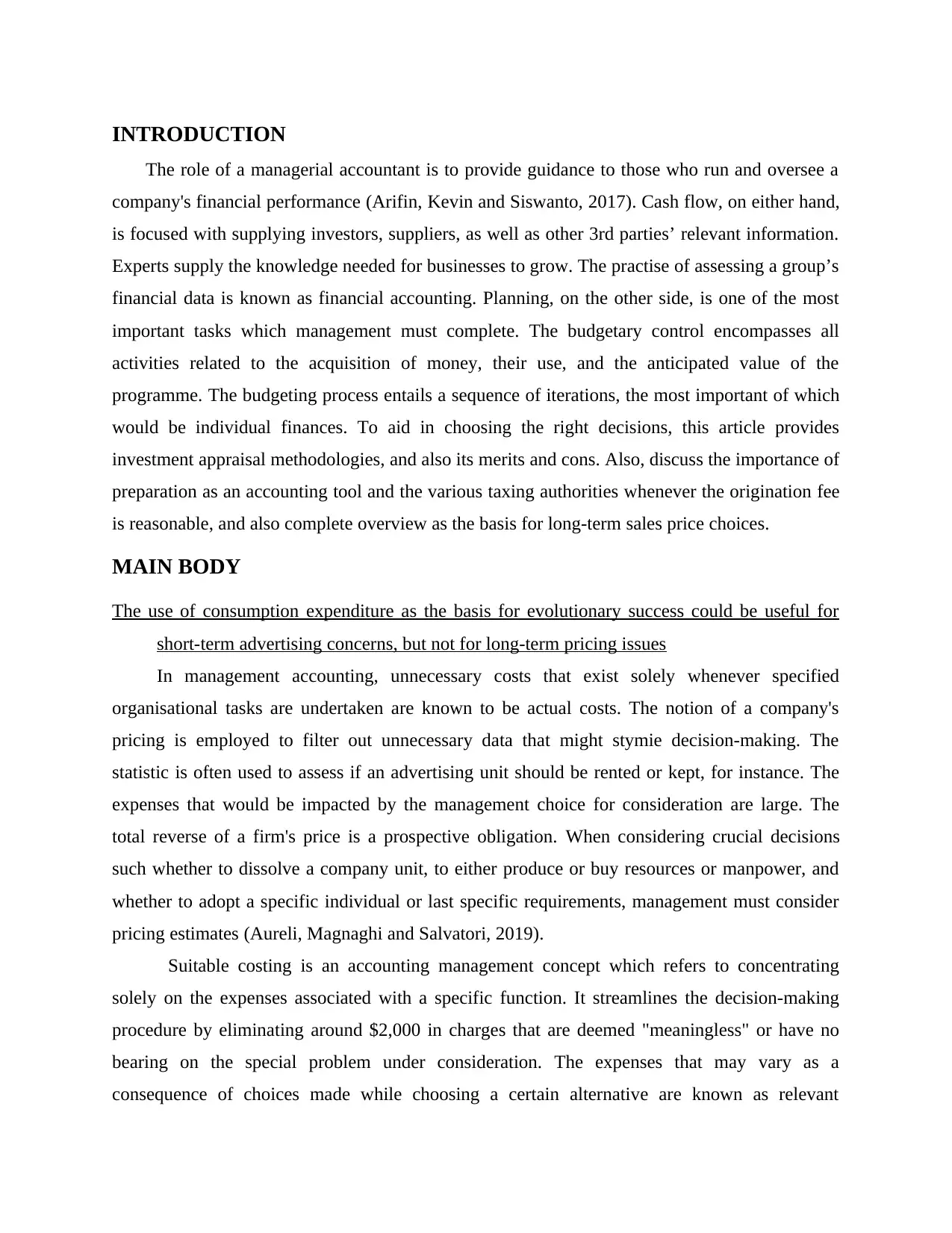
INTRODUCTION
The role of a managerial accountant is to provide guidance to those who run and oversee a
company's financial performance (Arifin, Kevin and Siswanto, 2017). Cash flow, on either hand,
is focused with supplying investors, suppliers, as well as other 3rd parties’ relevant information.
Experts supply the knowledge needed for businesses to grow. The practise of assessing a group’s
financial data is known as financial accounting. Planning, on the other side, is one of the most
important tasks which management must complete. The budgetary control encompasses all
activities related to the acquisition of money, their use, and the anticipated value of the
programme. The budgeting process entails a sequence of iterations, the most important of which
would be individual finances. To aid in choosing the right decisions, this article provides
investment appraisal methodologies, and also its merits and cons. Also, discuss the importance of
preparation as an accounting tool and the various taxing authorities whenever the origination fee
is reasonable, and also complete overview as the basis for long-term sales price choices.
MAIN BODY
The use of consumption expenditure as the basis for evolutionary success could be useful for
short-term advertising concerns, but not for long-term pricing issues
In management accounting, unnecessary costs that exist solely whenever specified
organisational tasks are undertaken are known to be actual costs. The notion of a company's
pricing is employed to filter out unnecessary data that might stymie decision-making. The
statistic is often used to assess if an advertising unit should be rented or kept, for instance. The
expenses that would be impacted by the management choice for consideration are large. The
total reverse of a firm's price is a prospective obligation. When considering crucial decisions
such whether to dissolve a company unit, to either produce or buy resources or manpower, and
whether to adopt a specific individual or last specific requirements, management must consider
pricing estimates (Aureli, Magnaghi and Salvatori, 2019).
Suitable costing is an accounting management concept which refers to concentrating
solely on the expenses associated with a specific function. It streamlines the decision-making
procedure by eliminating around $2,000 in charges that are deemed "meaningless" or have no
bearing on the special problem under consideration. The expenses that may vary as a
consequence of choices made while choosing a certain alternative are known as relevant
The role of a managerial accountant is to provide guidance to those who run and oversee a
company's financial performance (Arifin, Kevin and Siswanto, 2017). Cash flow, on either hand,
is focused with supplying investors, suppliers, as well as other 3rd parties’ relevant information.
Experts supply the knowledge needed for businesses to grow. The practise of assessing a group’s
financial data is known as financial accounting. Planning, on the other side, is one of the most
important tasks which management must complete. The budgetary control encompasses all
activities related to the acquisition of money, their use, and the anticipated value of the
programme. The budgeting process entails a sequence of iterations, the most important of which
would be individual finances. To aid in choosing the right decisions, this article provides
investment appraisal methodologies, and also its merits and cons. Also, discuss the importance of
preparation as an accounting tool and the various taxing authorities whenever the origination fee
is reasonable, and also complete overview as the basis for long-term sales price choices.
MAIN BODY
The use of consumption expenditure as the basis for evolutionary success could be useful for
short-term advertising concerns, but not for long-term pricing issues
In management accounting, unnecessary costs that exist solely whenever specified
organisational tasks are undertaken are known to be actual costs. The notion of a company's
pricing is employed to filter out unnecessary data that might stymie decision-making. The
statistic is often used to assess if an advertising unit should be rented or kept, for instance. The
expenses that would be impacted by the management choice for consideration are large. The
total reverse of a firm's price is a prospective obligation. When considering crucial decisions
such whether to dissolve a company unit, to either produce or buy resources or manpower, and
whether to adopt a specific individual or last specific requirements, management must consider
pricing estimates (Aureli, Magnaghi and Salvatori, 2019).
Suitable costing is an accounting management concept which refers to concentrating
solely on the expenses associated with a specific function. It streamlines the decision-making
procedure by eliminating around $2,000 in charges that are deemed "meaningless" or have no
bearing on the special problem under consideration. The expenses that may vary as a
consequence of choices made while choosing a certain alternative are known as relevant
Paraphrase This Document
Need a fresh take? Get an instant paraphrase of this document with our AI Paraphraser

expenses. Reasonable price is frequently employed in fast decision-making, as evidenced by the
examples in this paragraph. For instance, a space has been reserved for a business event
scheduled for the next two months, but attendance has been minimal, and the meeting appears to
be a waste of time. By applying relevant price in this scenario, it is assumed that this activity
would not result in a profit; the problem is calculating whether alternative, conducting the event
or stopping it, will result in the lowest degree of losses. It was a loan modifications judgment that
was taken. Unimportant expenses are still compensated by the activities corporation, but the
important as well as crucial component is that they have no bearing on the particular decision
being made – regardless of whether option A or option B is selected, all unneeded expenses will
be compensated, so they are ignored in aspects of the particular decision.
Firms make judgments in order to achieve both brief & medium term goals, and even in
some cases, simultaneously. Extended evaluations are more concerned with long-term
management of grievances and achieving major objectives, whereas quick decisions are
frequently made in response to a brief circumstance or a strong demand. Since these two types of
findings need various types of study, we'll explore rapid and solid evaluation and also lengthy
review in Financial Report study. Short as well as long run judgments are distinguishable in
accountancy not only due to differences in how they are used in practise, but also because the
kinds of evaluations performed on short- and long-term choices are different. Further expenses
are becoming more significant to the decision-making procedure as the time period over which
the choice has an effect grows. Furthermore, when a time component is taken into account, other
variables such as income (provided or obtained) have a greater impact on decisions (Bozdo,
2020).
Examine the benefits and limits of different fiscal administration systems when picking between
alternative investment options
Fiscal planning, also referred as capital expenditure evaluation, is a decision-making
approach for analysing a company's long-term expenditures. Infrastructure, technologies, R&D
operations, tv commercials, development circumstances, technological advances, as well as other
aspects of the organisation are all included in this type of comprehensive spending review. To
put it different way, asset appraisal assessment is a means of allocating major growth
expenditure to company expenses. Capital expenditure evaluations are used by small - medium
examples in this paragraph. For instance, a space has been reserved for a business event
scheduled for the next two months, but attendance has been minimal, and the meeting appears to
be a waste of time. By applying relevant price in this scenario, it is assumed that this activity
would not result in a profit; the problem is calculating whether alternative, conducting the event
or stopping it, will result in the lowest degree of losses. It was a loan modifications judgment that
was taken. Unimportant expenses are still compensated by the activities corporation, but the
important as well as crucial component is that they have no bearing on the particular decision
being made – regardless of whether option A or option B is selected, all unneeded expenses will
be compensated, so they are ignored in aspects of the particular decision.
Firms make judgments in order to achieve both brief & medium term goals, and even in
some cases, simultaneously. Extended evaluations are more concerned with long-term
management of grievances and achieving major objectives, whereas quick decisions are
frequently made in response to a brief circumstance or a strong demand. Since these two types of
findings need various types of study, we'll explore rapid and solid evaluation and also lengthy
review in Financial Report study. Short as well as long run judgments are distinguishable in
accountancy not only due to differences in how they are used in practise, but also because the
kinds of evaluations performed on short- and long-term choices are different. Further expenses
are becoming more significant to the decision-making procedure as the time period over which
the choice has an effect grows. Furthermore, when a time component is taken into account, other
variables such as income (provided or obtained) have a greater impact on decisions (Bozdo,
2020).
Examine the benefits and limits of different fiscal administration systems when picking between
alternative investment options
Fiscal planning, also referred as capital expenditure evaluation, is a decision-making
approach for analysing a company's long-term expenditures. Infrastructure, technologies, R&D
operations, tv commercials, development circumstances, technological advances, as well as other
aspects of the organisation are all included in this type of comprehensive spending review. To
put it different way, asset appraisal assessment is a means of allocating major growth
expenditure to company expenses. Capital expenditure evaluations are used by small - medium
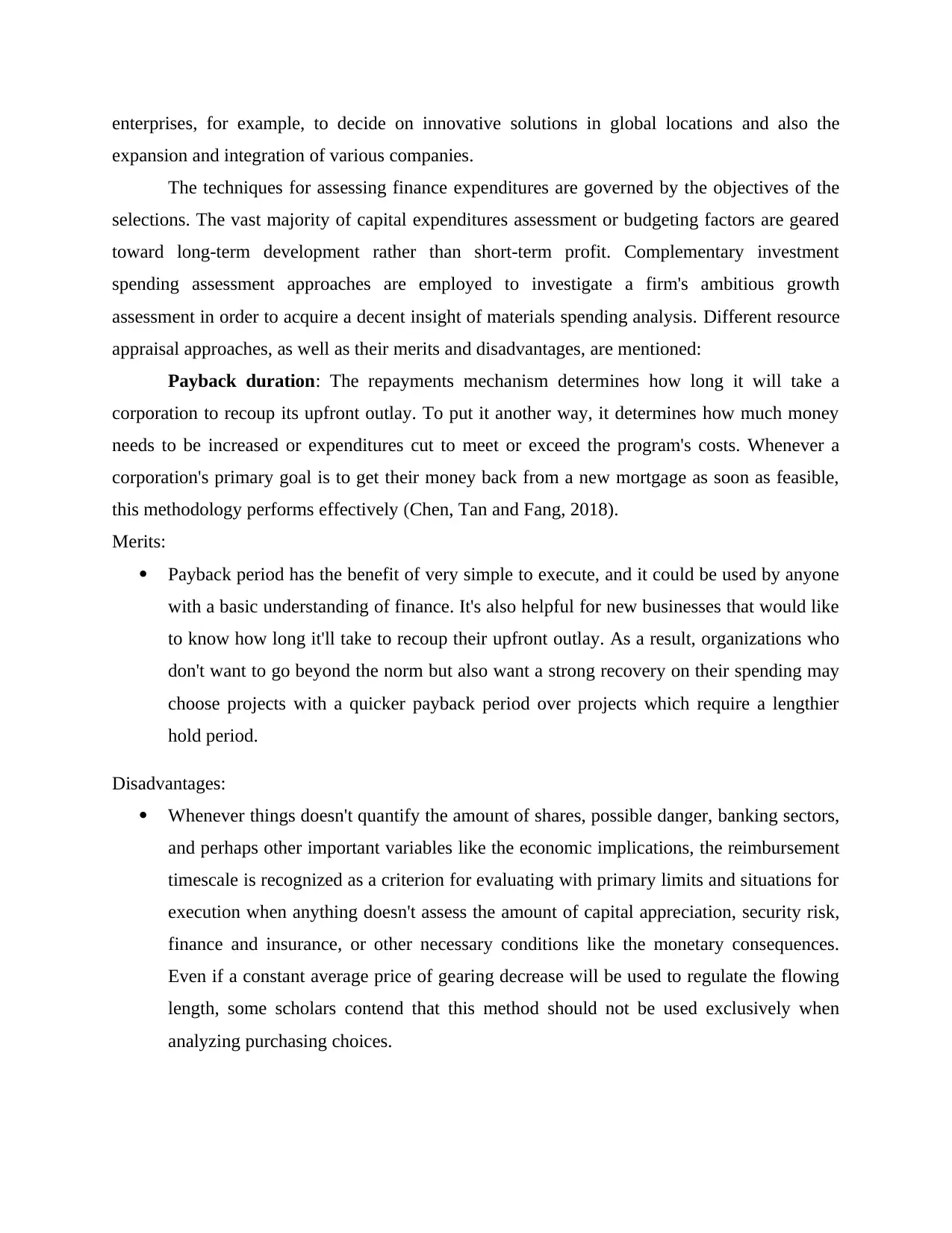
enterprises, for example, to decide on innovative solutions in global locations and also the
expansion and integration of various companies.
The techniques for assessing finance expenditures are governed by the objectives of the
selections. The vast majority of capital expenditures assessment or budgeting factors are geared
toward long-term development rather than short-term profit. Complementary investment
spending assessment approaches are employed to investigate a firm's ambitious growth
assessment in order to acquire a decent insight of materials spending analysis. Different resource
appraisal approaches, as well as their merits and disadvantages, are mentioned:
Payback duration: The repayments mechanism determines how long it will take a
corporation to recoup its upfront outlay. To put it another way, it determines how much money
needs to be increased or expenditures cut to meet or exceed the program's costs. Whenever a
corporation's primary goal is to get their money back from a new mortgage as soon as feasible,
this methodology performs effectively (Chen, Tan and Fang, 2018).
Merits:
Payback period has the benefit of very simple to execute, and it could be used by anyone
with a basic understanding of finance. It's also helpful for new businesses that would like
to know how long it'll take to recoup their upfront outlay. As a result, organizations who
don't want to go beyond the norm but also want a strong recovery on their spending may
choose projects with a quicker payback period over projects which require a lengthier
hold period.
Disadvantages:
Whenever things doesn't quantify the amount of shares, possible danger, banking sectors,
and perhaps other important variables like the economic implications, the reimbursement
timescale is recognized as a criterion for evaluating with primary limits and situations for
execution when anything doesn't assess the amount of capital appreciation, security risk,
finance and insurance, or other necessary conditions like the monetary consequences.
Even if a constant average price of gearing decrease will be used to regulate the flowing
length, some scholars contend that this method should not be used exclusively when
analyzing purchasing choices.
expansion and integration of various companies.
The techniques for assessing finance expenditures are governed by the objectives of the
selections. The vast majority of capital expenditures assessment or budgeting factors are geared
toward long-term development rather than short-term profit. Complementary investment
spending assessment approaches are employed to investigate a firm's ambitious growth
assessment in order to acquire a decent insight of materials spending analysis. Different resource
appraisal approaches, as well as their merits and disadvantages, are mentioned:
Payback duration: The repayments mechanism determines how long it will take a
corporation to recoup its upfront outlay. To put it another way, it determines how much money
needs to be increased or expenditures cut to meet or exceed the program's costs. Whenever a
corporation's primary goal is to get their money back from a new mortgage as soon as feasible,
this methodology performs effectively (Chen, Tan and Fang, 2018).
Merits:
Payback period has the benefit of very simple to execute, and it could be used by anyone
with a basic understanding of finance. It's also helpful for new businesses that would like
to know how long it'll take to recoup their upfront outlay. As a result, organizations who
don't want to go beyond the norm but also want a strong recovery on their spending may
choose projects with a quicker payback period over projects which require a lengthier
hold period.
Disadvantages:
Whenever things doesn't quantify the amount of shares, possible danger, banking sectors,
and perhaps other important variables like the economic implications, the reimbursement
timescale is recognized as a criterion for evaluating with primary limits and situations for
execution when anything doesn't assess the amount of capital appreciation, security risk,
finance and insurance, or other necessary conditions like the monetary consequences.
Even if a constant average price of gearing decrease will be used to regulate the flowing
length, some scholars contend that this method should not be used exclusively when
analyzing purchasing choices.
⊘ This is a preview!⊘
Do you want full access?
Subscribe today to unlock all pages.

Trusted by 1+ million students worldwide
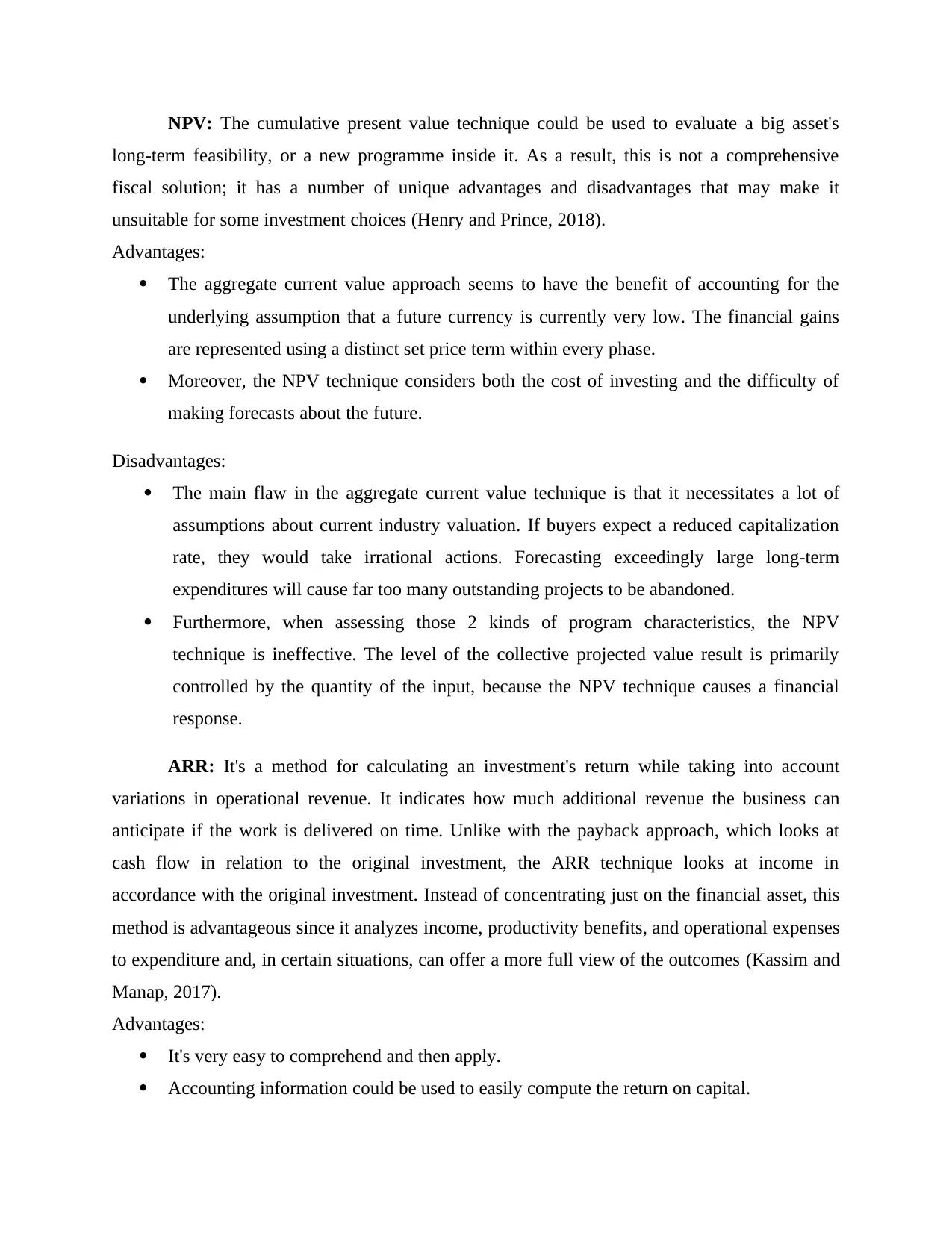
NPV: The cumulative present value technique could be used to evaluate a big asset's
long-term feasibility, or a new programme inside it. As a result, this is not a comprehensive
fiscal solution; it has a number of unique advantages and disadvantages that may make it
unsuitable for some investment choices (Henry and Prince, 2018).
Advantages:
The aggregate current value approach seems to have the benefit of accounting for the
underlying assumption that a future currency is currently very low. The financial gains
are represented using a distinct set price term within every phase.
Moreover, the NPV technique considers both the cost of investing and the difficulty of
making forecasts about the future.
Disadvantages:
The main flaw in the aggregate current value technique is that it necessitates a lot of
assumptions about current industry valuation. If buyers expect a reduced capitalization
rate, they would take irrational actions. Forecasting exceedingly large long-term
expenditures will cause far too many outstanding projects to be abandoned.
Furthermore, when assessing those 2 kinds of program characteristics, the NPV
technique is ineffective. The level of the collective projected value result is primarily
controlled by the quantity of the input, because the NPV technique causes a financial
response.
ARR: It's a method for calculating an investment's return while taking into account
variations in operational revenue. It indicates how much additional revenue the business can
anticipate if the work is delivered on time. Unlike with the payback approach, which looks at
cash flow in relation to the original investment, the ARR technique looks at income in
accordance with the original investment. Instead of concentrating just on the financial asset, this
method is advantageous since it analyzes income, productivity benefits, and operational expenses
to expenditure and, in certain situations, can offer a more full view of the outcomes (Kassim and
Manap, 2017).
Advantages:
It's very easy to comprehend and then apply.
Accounting information could be used to easily compute the return on capital.
long-term feasibility, or a new programme inside it. As a result, this is not a comprehensive
fiscal solution; it has a number of unique advantages and disadvantages that may make it
unsuitable for some investment choices (Henry and Prince, 2018).
Advantages:
The aggregate current value approach seems to have the benefit of accounting for the
underlying assumption that a future currency is currently very low. The financial gains
are represented using a distinct set price term within every phase.
Moreover, the NPV technique considers both the cost of investing and the difficulty of
making forecasts about the future.
Disadvantages:
The main flaw in the aggregate current value technique is that it necessitates a lot of
assumptions about current industry valuation. If buyers expect a reduced capitalization
rate, they would take irrational actions. Forecasting exceedingly large long-term
expenditures will cause far too many outstanding projects to be abandoned.
Furthermore, when assessing those 2 kinds of program characteristics, the NPV
technique is ineffective. The level of the collective projected value result is primarily
controlled by the quantity of the input, because the NPV technique causes a financial
response.
ARR: It's a method for calculating an investment's return while taking into account
variations in operational revenue. It indicates how much additional revenue the business can
anticipate if the work is delivered on time. Unlike with the payback approach, which looks at
cash flow in relation to the original investment, the ARR technique looks at income in
accordance with the original investment. Instead of concentrating just on the financial asset, this
method is advantageous since it analyzes income, productivity benefits, and operational expenses
to expenditure and, in certain situations, can offer a more full view of the outcomes (Kassim and
Manap, 2017).
Advantages:
It's very easy to comprehend and then apply.
Accounting information could be used to easily compute the return on capital.
Paraphrase This Document
Need a fresh take? Get an instant paraphrase of this document with our AI Paraphraser
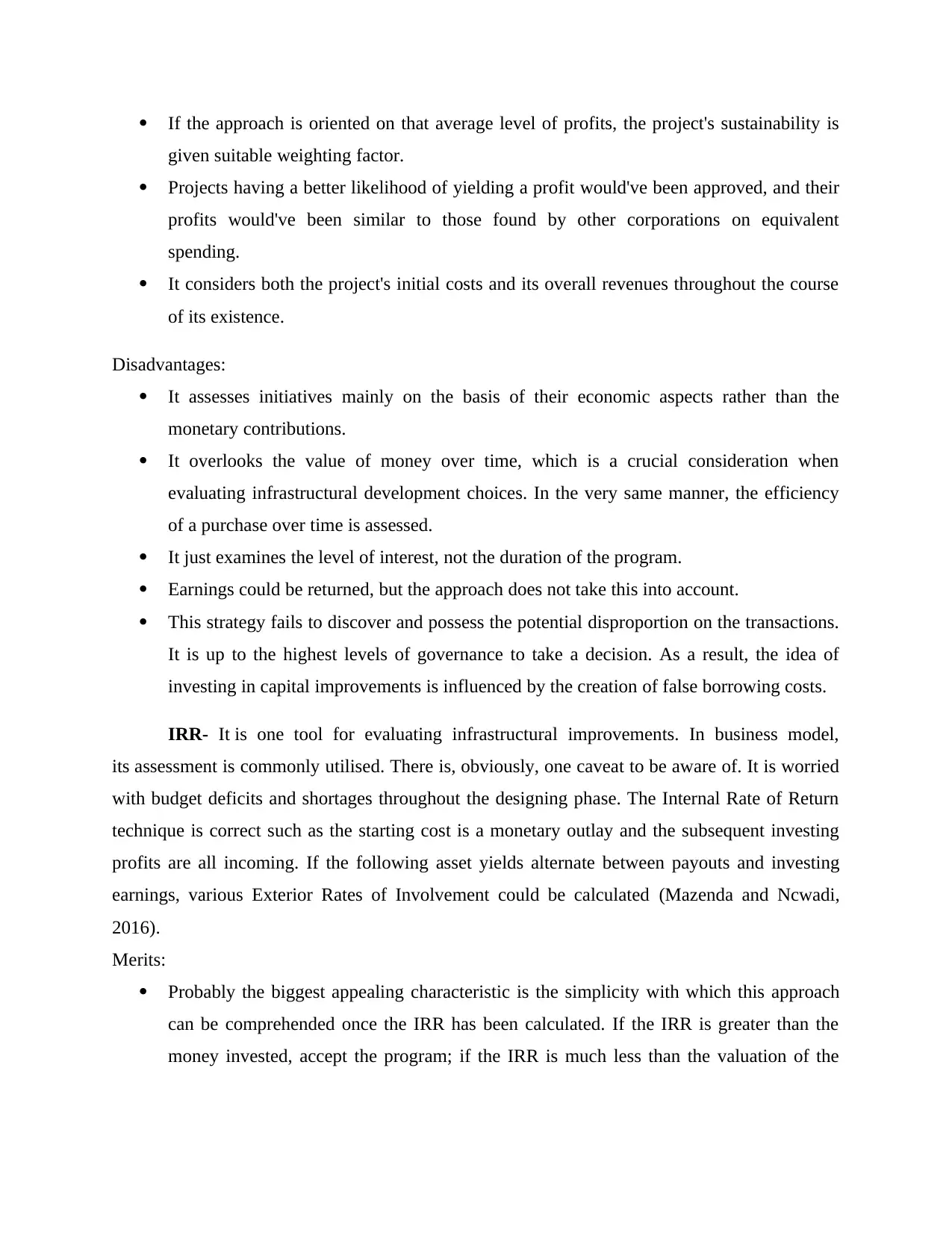
If the approach is oriented on that average level of profits, the project's sustainability is
given suitable weighting factor.
Projects having a better likelihood of yielding a profit would've been approved, and their
profits would've been similar to those found by other corporations on equivalent
spending.
It considers both the project's initial costs and its overall revenues throughout the course
of its existence.
Disadvantages:
It assesses initiatives mainly on the basis of their economic aspects rather than the
monetary contributions.
It overlooks the value of money over time, which is a crucial consideration when
evaluating infrastructural development choices. In the very same manner, the efficiency
of a purchase over time is assessed.
It just examines the level of interest, not the duration of the program.
Earnings could be returned, but the approach does not take this into account.
This strategy fails to discover and possess the potential disproportion on the transactions.
It is up to the highest levels of governance to take a decision. As a result, the idea of
investing in capital improvements is influenced by the creation of false borrowing costs.
IRR- It is one tool for evaluating infrastructural improvements. In business model,
its assessment is commonly utilised. There is, obviously, one caveat to be aware of. It is worried
with budget deficits and shortages throughout the designing phase. The Internal Rate of Return
technique is correct such as the starting cost is a monetary outlay and the subsequent investing
profits are all incoming. If the following asset yields alternate between payouts and investing
earnings, various Exterior Rates of Involvement could be calculated (Mazenda and Ncwadi,
2016).
Merits:
Probably the biggest appealing characteristic is the simplicity with which this approach
can be comprehended once the IRR has been calculated. If the IRR is greater than the
money invested, accept the program; if the IRR is much less than the valuation of the
given suitable weighting factor.
Projects having a better likelihood of yielding a profit would've been approved, and their
profits would've been similar to those found by other corporations on equivalent
spending.
It considers both the project's initial costs and its overall revenues throughout the course
of its existence.
Disadvantages:
It assesses initiatives mainly on the basis of their economic aspects rather than the
monetary contributions.
It overlooks the value of money over time, which is a crucial consideration when
evaluating infrastructural development choices. In the very same manner, the efficiency
of a purchase over time is assessed.
It just examines the level of interest, not the duration of the program.
Earnings could be returned, but the approach does not take this into account.
This strategy fails to discover and possess the potential disproportion on the transactions.
It is up to the highest levels of governance to take a decision. As a result, the idea of
investing in capital improvements is influenced by the creation of false borrowing costs.
IRR- It is one tool for evaluating infrastructural improvements. In business model,
its assessment is commonly utilised. There is, obviously, one caveat to be aware of. It is worried
with budget deficits and shortages throughout the designing phase. The Internal Rate of Return
technique is correct such as the starting cost is a monetary outlay and the subsequent investing
profits are all incoming. If the following asset yields alternate between payouts and investing
earnings, various Exterior Rates of Involvement could be calculated (Mazenda and Ncwadi,
2016).
Merits:
Probably the biggest appealing characteristic is the simplicity with which this approach
can be comprehended once the IRR has been calculated. If the IRR is greater than the
money invested, accept the program; if the IRR is much less than the valuation of the
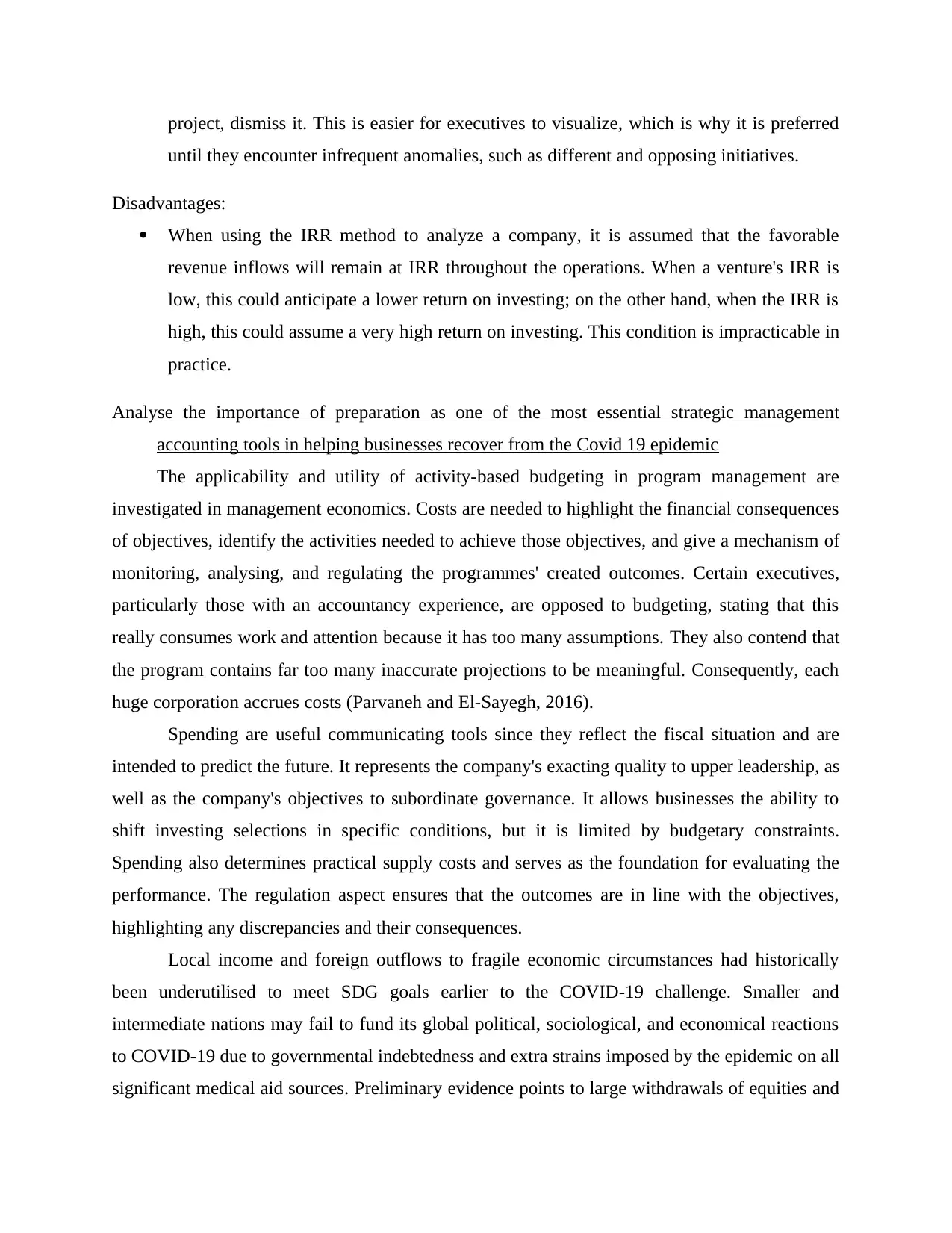
project, dismiss it. This is easier for executives to visualize, which is why it is preferred
until they encounter infrequent anomalies, such as different and opposing initiatives.
Disadvantages:
When using the IRR method to analyze a company, it is assumed that the favorable
revenue inflows will remain at IRR throughout the operations. When a venture's IRR is
low, this could anticipate a lower return on investing; on the other hand, when the IRR is
high, this could assume a very high return on investing. This condition is impracticable in
practice.
Analyse the importance of preparation as one of the most essential strategic management
accounting tools in helping businesses recover from the Covid 19 epidemic
The applicability and utility of activity-based budgeting in program management are
investigated in management economics. Costs are needed to highlight the financial consequences
of objectives, identify the activities needed to achieve those objectives, and give a mechanism of
monitoring, analysing, and regulating the programmes' created outcomes. Certain executives,
particularly those with an accountancy experience, are opposed to budgeting, stating that this
really consumes work and attention because it has too many assumptions. They also contend that
the program contains far too many inaccurate projections to be meaningful. Consequently, each
huge corporation accrues costs (Parvaneh and El-Sayegh, 2016).
Spending are useful communicating tools since they reflect the fiscal situation and are
intended to predict the future. It represents the company's exacting quality to upper leadership, as
well as the company's objectives to subordinate governance. It allows businesses the ability to
shift investing selections in specific conditions, but it is limited by budgetary constraints.
Spending also determines practical supply costs and serves as the foundation for evaluating the
performance. The regulation aspect ensures that the outcomes are in line with the objectives,
highlighting any discrepancies and their consequences.
Local income and foreign outflows to fragile economic circumstances had historically
been underutilised to meet SDG goals earlier to the COVID-19 challenge. Smaller and
intermediate nations may fail to fund its global political, sociological, and economical reactions
to COVID-19 due to governmental indebtedness and extra strains imposed by the epidemic on all
significant medical aid sources. Preliminary evidence points to large withdrawals of equities and
until they encounter infrequent anomalies, such as different and opposing initiatives.
Disadvantages:
When using the IRR method to analyze a company, it is assumed that the favorable
revenue inflows will remain at IRR throughout the operations. When a venture's IRR is
low, this could anticipate a lower return on investing; on the other hand, when the IRR is
high, this could assume a very high return on investing. This condition is impracticable in
practice.
Analyse the importance of preparation as one of the most essential strategic management
accounting tools in helping businesses recover from the Covid 19 epidemic
The applicability and utility of activity-based budgeting in program management are
investigated in management economics. Costs are needed to highlight the financial consequences
of objectives, identify the activities needed to achieve those objectives, and give a mechanism of
monitoring, analysing, and regulating the programmes' created outcomes. Certain executives,
particularly those with an accountancy experience, are opposed to budgeting, stating that this
really consumes work and attention because it has too many assumptions. They also contend that
the program contains far too many inaccurate projections to be meaningful. Consequently, each
huge corporation accrues costs (Parvaneh and El-Sayegh, 2016).
Spending are useful communicating tools since they reflect the fiscal situation and are
intended to predict the future. It represents the company's exacting quality to upper leadership, as
well as the company's objectives to subordinate governance. It allows businesses the ability to
shift investing selections in specific conditions, but it is limited by budgetary constraints.
Spending also determines practical supply costs and serves as the foundation for evaluating the
performance. The regulation aspect ensures that the outcomes are in line with the objectives,
highlighting any discrepancies and their consequences.
Local income and foreign outflows to fragile economic circumstances had historically
been underutilised to meet SDG goals earlier to the COVID-19 challenge. Smaller and
intermediate nations may fail to fund its global political, sociological, and economical reactions
to COVID-19 due to governmental indebtedness and extra strains imposed by the epidemic on all
significant medical aid sources. Preliminary evidence points to large withdrawals of equities and
⊘ This is a preview!⊘
Do you want full access?
Subscribe today to unlock all pages.

Trusted by 1+ million students worldwide

assets from emerging nations, as well as compounding budgetary consequences previously
generated by affluence and socioeconomic worries. Depending on their management of
government funds and regulations established, different nations have chosen a range of financing
tiers schemes. To manage such a firm's growth and fiscal limits, changes to the accounting
records of preparation (such as loans) are needed. At the regional stage, a wise budgeting
decision is also required. That's where the paper's emphasis would've been. Every management
must devise its own method for assigning monetary resources to activities. A look of several
wealthy nations' traditional budgeting systems in order to advice monetary responses in nations
where the epidemic is projected to expand in the next decade (Shapiro and Hanouna, 2019).
Examine the various approaches that a country's tax authorities would use to determine if a
transactional prices of inventory is reasonable
Multinational firms and funding agencies can calculate correct arms length monetary
measures for activities involving several connected companies using a variety of methods.
Multinational enterprises and revenue authorities might apply one of five different transferable
pricing methodologies, according to the Organization for Intergovernmental Co-Operative and
Development. We examine the five ways and provide instances for each to assist organisations in
determining which is the most appropriate and productive.
Reselling price approach- The reselling cost - based pricing is another common approach
for determining taxation legislation. The retargeting cost of a good purchased from a related firm
and subsequently resold to a third party is the starting point for this strategy. The reselling value
is the cost of the transactions in which the item is relocated to a certain company. The next stage
is to figure out the profit margin categories, which are the quantities of cash required by the
company supplying the things to cover marketing and administration costs. To determine arms-
length pricing, the reselling costing approach uses equivalent residual value subcategories. This
implies that things like whether or not a guarantee is given (and how it's managed) must be
considered (Sonnenberg, 2018).
Unified communications and deregulated pricing systems: The OECD classifies the CUP
approach as a basic commercial technique. It compares and analyzes the cost of a product or
service, as well as the terms and regulations of a governed vs. go-to-pay environment. In
particular, the CUP technique necessitates the proper extraction of information from company
generated by affluence and socioeconomic worries. Depending on their management of
government funds and regulations established, different nations have chosen a range of financing
tiers schemes. To manage such a firm's growth and fiscal limits, changes to the accounting
records of preparation (such as loans) are needed. At the regional stage, a wise budgeting
decision is also required. That's where the paper's emphasis would've been. Every management
must devise its own method for assigning monetary resources to activities. A look of several
wealthy nations' traditional budgeting systems in order to advice monetary responses in nations
where the epidemic is projected to expand in the next decade (Shapiro and Hanouna, 2019).
Examine the various approaches that a country's tax authorities would use to determine if a
transactional prices of inventory is reasonable
Multinational firms and funding agencies can calculate correct arms length monetary
measures for activities involving several connected companies using a variety of methods.
Multinational enterprises and revenue authorities might apply one of five different transferable
pricing methodologies, according to the Organization for Intergovernmental Co-Operative and
Development. We examine the five ways and provide instances for each to assist organisations in
determining which is the most appropriate and productive.
Reselling price approach- The reselling cost - based pricing is another common approach
for determining taxation legislation. The retargeting cost of a good purchased from a related firm
and subsequently resold to a third party is the starting point for this strategy. The reselling value
is the cost of the transactions in which the item is relocated to a certain company. The next stage
is to figure out the profit margin categories, which are the quantities of cash required by the
company supplying the things to cover marketing and administration costs. To determine arms-
length pricing, the reselling costing approach uses equivalent residual value subcategories. This
implies that things like whether or not a guarantee is given (and how it's managed) must be
considered (Sonnenberg, 2018).
Unified communications and deregulated pricing systems: The OECD classifies the CUP
approach as a basic commercial technique. It compares and analyzes the cost of a product or
service, as well as the terms and regulations of a governed vs. go-to-pay environment. In
particular, the CUP technique necessitates the proper extraction of information from company
Paraphrase This Document
Need a fresh take? Get an instant paraphrase of this document with our AI Paraphraser
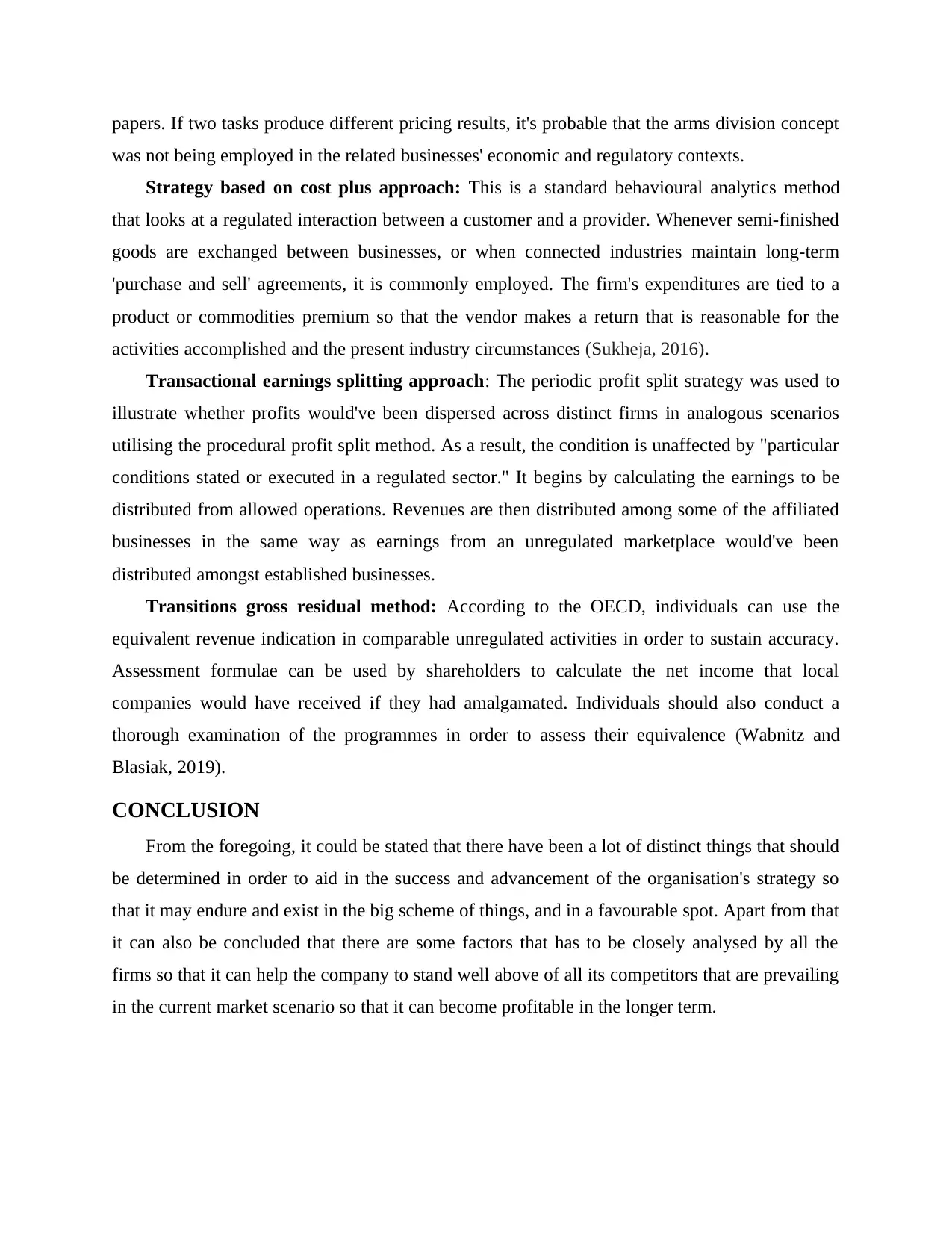
papers. If two tasks produce different pricing results, it's probable that the arms division concept
was not being employed in the related businesses' economic and regulatory contexts.
Strategy based on cost plus approach: This is a standard behavioural analytics method
that looks at a regulated interaction between a customer and a provider. Whenever semi-finished
goods are exchanged between businesses, or when connected industries maintain long-term
'purchase and sell' agreements, it is commonly employed. The firm's expenditures are tied to a
product or commodities premium so that the vendor makes a return that is reasonable for the
activities accomplished and the present industry circumstances (Sukheja, 2016).
Transactional earnings splitting approach: The periodic profit split strategy was used to
illustrate whether profits would've been dispersed across distinct firms in analogous scenarios
utilising the procedural profit split method. As a result, the condition is unaffected by "particular
conditions stated or executed in a regulated sector." It begins by calculating the earnings to be
distributed from allowed operations. Revenues are then distributed among some of the affiliated
businesses in the same way as earnings from an unregulated marketplace would've been
distributed amongst established businesses.
Transitions gross residual method: According to the OECD, individuals can use the
equivalent revenue indication in comparable unregulated activities in order to sustain accuracy.
Assessment formulae can be used by shareholders to calculate the net income that local
companies would have received if they had amalgamated. Individuals should also conduct a
thorough examination of the programmes in order to assess their equivalence (Wabnitz and
Blasiak, 2019).
CONCLUSION
From the foregoing, it could be stated that there have been a lot of distinct things that should
be determined in order to aid in the success and advancement of the organisation's strategy so
that it may endure and exist in the big scheme of things, and in a favourable spot. Apart from that
it can also be concluded that there are some factors that has to be closely analysed by all the
firms so that it can help the company to stand well above of all its competitors that are prevailing
in the current market scenario so that it can become profitable in the longer term.
was not being employed in the related businesses' economic and regulatory contexts.
Strategy based on cost plus approach: This is a standard behavioural analytics method
that looks at a regulated interaction between a customer and a provider. Whenever semi-finished
goods are exchanged between businesses, or when connected industries maintain long-term
'purchase and sell' agreements, it is commonly employed. The firm's expenditures are tied to a
product or commodities premium so that the vendor makes a return that is reasonable for the
activities accomplished and the present industry circumstances (Sukheja, 2016).
Transactional earnings splitting approach: The periodic profit split strategy was used to
illustrate whether profits would've been dispersed across distinct firms in analogous scenarios
utilising the procedural profit split method. As a result, the condition is unaffected by "particular
conditions stated or executed in a regulated sector." It begins by calculating the earnings to be
distributed from allowed operations. Revenues are then distributed among some of the affiliated
businesses in the same way as earnings from an unregulated marketplace would've been
distributed amongst established businesses.
Transitions gross residual method: According to the OECD, individuals can use the
equivalent revenue indication in comparable unregulated activities in order to sustain accuracy.
Assessment formulae can be used by shareholders to calculate the net income that local
companies would have received if they had amalgamated. Individuals should also conduct a
thorough examination of the programmes in order to assess their equivalence (Wabnitz and
Blasiak, 2019).
CONCLUSION
From the foregoing, it could be stated that there have been a lot of distinct things that should
be determined in order to aid in the success and advancement of the organisation's strategy so
that it may endure and exist in the big scheme of things, and in a favourable spot. Apart from that
it can also be concluded that there are some factors that has to be closely analysed by all the
firms so that it can help the company to stand well above of all its competitors that are prevailing
in the current market scenario so that it can become profitable in the longer term.
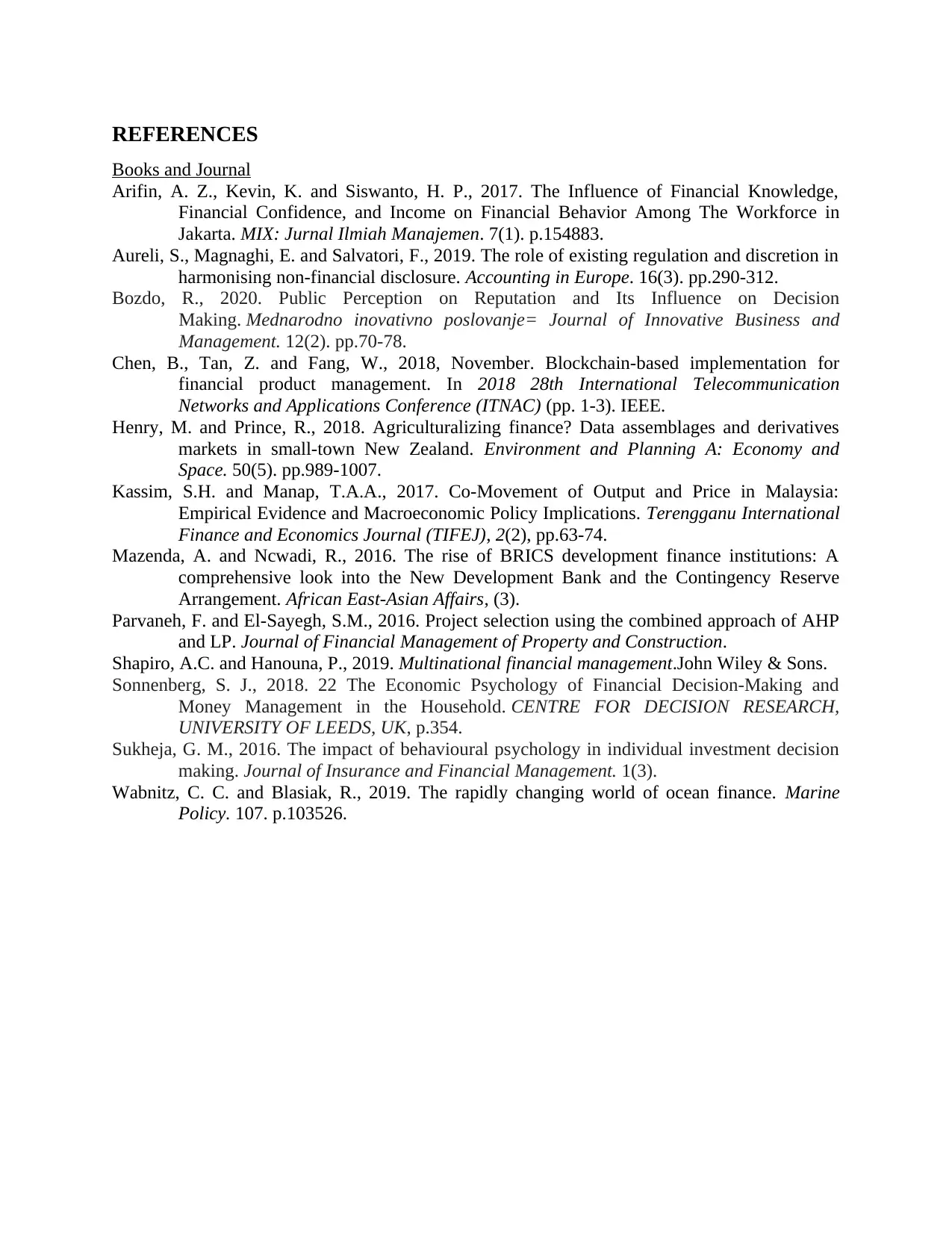
REFERENCES
Books and Journal
Arifin, A. Z., Kevin, K. and Siswanto, H. P., 2017. The Influence of Financial Knowledge,
Financial Confidence, and Income on Financial Behavior Among The Workforce in
Jakarta. MIX: Jurnal Ilmiah Manajemen. 7(1). p.154883.
Aureli, S., Magnaghi, E. and Salvatori, F., 2019. The role of existing regulation and discretion in
harmonising non-financial disclosure. Accounting in Europe. 16(3). pp.290-312.
Bozdo, R., 2020. Public Perception on Reputation and Its Influence on Decision
Making. Mednarodno inovativno poslovanje= Journal of Innovative Business and
Management. 12(2). pp.70-78.
Chen, B., Tan, Z. and Fang, W., 2018, November. Blockchain-based implementation for
financial product management. In 2018 28th International Telecommunication
Networks and Applications Conference (ITNAC) (pp. 1-3). IEEE.
Henry, M. and Prince, R., 2018. Agriculturalizing finance? Data assemblages and derivatives
markets in small-town New Zealand. Environment and Planning A: Economy and
Space. 50(5). pp.989-1007.
Kassim, S.H. and Manap, T.A.A., 2017. Co-Movement of Output and Price in Malaysia:
Empirical Evidence and Macroeconomic Policy Implications. Terengganu International
Finance and Economics Journal (TIFEJ), 2(2), pp.63-74.
Mazenda, A. and Ncwadi, R., 2016. The rise of BRICS development finance institutions: A
comprehensive look into the New Development Bank and the Contingency Reserve
Arrangement. African East-Asian Affairs, (3).
Parvaneh, F. and El-Sayegh, S.M., 2016. Project selection using the combined approach of AHP
and LP. Journal of Financial Management of Property and Construction.
Shapiro, A.C. and Hanouna, P., 2019. Multinational financial management.John Wiley & Sons.
Sonnenberg, S. J., 2018. 22 The Economic Psychology of Financial Decision-Making and
Money Management in the Household. CENTRE FOR DECISION RESEARCH,
UNIVERSITY OF LEEDS, UK, p.354.
Sukheja, G. M., 2016. The impact of behavioural psychology in individual investment decision
making. Journal of Insurance and Financial Management. 1(3).
Wabnitz, C. C. and Blasiak, R., 2019. The rapidly changing world of ocean finance. Marine
Policy. 107. p.103526.
Books and Journal
Arifin, A. Z., Kevin, K. and Siswanto, H. P., 2017. The Influence of Financial Knowledge,
Financial Confidence, and Income on Financial Behavior Among The Workforce in
Jakarta. MIX: Jurnal Ilmiah Manajemen. 7(1). p.154883.
Aureli, S., Magnaghi, E. and Salvatori, F., 2019. The role of existing regulation and discretion in
harmonising non-financial disclosure. Accounting in Europe. 16(3). pp.290-312.
Bozdo, R., 2020. Public Perception on Reputation and Its Influence on Decision
Making. Mednarodno inovativno poslovanje= Journal of Innovative Business and
Management. 12(2). pp.70-78.
Chen, B., Tan, Z. and Fang, W., 2018, November. Blockchain-based implementation for
financial product management. In 2018 28th International Telecommunication
Networks and Applications Conference (ITNAC) (pp. 1-3). IEEE.
Henry, M. and Prince, R., 2018. Agriculturalizing finance? Data assemblages and derivatives
markets in small-town New Zealand. Environment and Planning A: Economy and
Space. 50(5). pp.989-1007.
Kassim, S.H. and Manap, T.A.A., 2017. Co-Movement of Output and Price in Malaysia:
Empirical Evidence and Macroeconomic Policy Implications. Terengganu International
Finance and Economics Journal (TIFEJ), 2(2), pp.63-74.
Mazenda, A. and Ncwadi, R., 2016. The rise of BRICS development finance institutions: A
comprehensive look into the New Development Bank and the Contingency Reserve
Arrangement. African East-Asian Affairs, (3).
Parvaneh, F. and El-Sayegh, S.M., 2016. Project selection using the combined approach of AHP
and LP. Journal of Financial Management of Property and Construction.
Shapiro, A.C. and Hanouna, P., 2019. Multinational financial management.John Wiley & Sons.
Sonnenberg, S. J., 2018. 22 The Economic Psychology of Financial Decision-Making and
Money Management in the Household. CENTRE FOR DECISION RESEARCH,
UNIVERSITY OF LEEDS, UK, p.354.
Sukheja, G. M., 2016. The impact of behavioural psychology in individual investment decision
making. Journal of Insurance and Financial Management. 1(3).
Wabnitz, C. C. and Blasiak, R., 2019. The rapidly changing world of ocean finance. Marine
Policy. 107. p.103526.
⊘ This is a preview!⊘
Do you want full access?
Subscribe today to unlock all pages.

Trusted by 1+ million students worldwide
1 out of 12
Related Documents
Your All-in-One AI-Powered Toolkit for Academic Success.
+13062052269
info@desklib.com
Available 24*7 on WhatsApp / Email
![[object Object]](/_next/static/media/star-bottom.7253800d.svg)
Unlock your academic potential
Copyright © 2020–2025 A2Z Services. All Rights Reserved. Developed and managed by ZUCOL.



